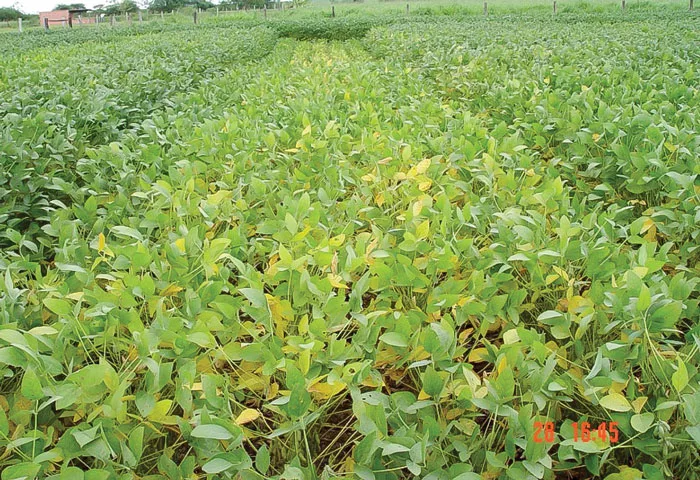When strip-tillers are looking to boost crop yields, it’s tempting to search for the “latest and greatest” product to find the solution. But sometimes farming from a job isn’t the answer. There could be some elusive reasons yields aren’t hitting expectations.
Micronutrients — such as boron, cobalt, copper, iron and molybdenum — only make up about 2% of a typical crop fertility program. But failing to manage them properly can hurt yield potential in a big way. Micros activate enzymes that speed up the engine of nutrient uptake and cycling, control disease, injuries and more, which helps plants meet their full potential.
Every micronutrient has a specific role it plays in the rhizosphere, whether it’s coming from residue, cover crops, an application or through natural processes. Here’s a rundown of the key micronutrients and what they do for your crops.
TAKEAWAYS
- In some situations, low soybean yields can be increases significantly with cobalt applications.
- In normal soils there typically isn’t enough iron in a plant available form, so soil organic matter is needed to break it down into a usable form.
- Boron toxicity can be a concern in sandy soils, but clay soils have enough buffering capacity in most cases to prevent that problem.
The Architect — Silica
Jim Hoorman, a retired NRCS educator, cover crop expert and owner of Hoorman Soil Health Services in Jenera, Ohio, says this nutrient gets very little mention, but it plays a key role in plant tissues in a way that provides strength, prevents lodging and facilitates stronger cell walls, and bigger stems and vascular structures — “so we can push more nutrients through that plant and it’s going to be healthier,” he notes. “And it activates a whole bunch of different things that we’re just starting to learn about.”
Organic silica is plant available and abundant in most soils and in organic residues. It tends to increase resistance to environmental stress, improve plant performance when the environment is hot and dry, and it’s associated with fewer instances of diseases, pathogens and insects. A proper level of silica also increases plant magnesium and chlorophyll.
Chlorophyll Facilitator — Iron
Iron is crucial because it activates the enzyme that makes chlorophyll, and it’s present in enzymes associated with energy transfer, nitrogen (N) production and fixation and lignin formation.
Iron is a relatively abundant nutrient and is plant available in reduced forms. This micro is very sensitive to soil pH, as every increase of 1 unit decreases iron levels by a factor of 1,000, Hoorman notes. In normal soils there typically isn’t enough iron in a plant available form, so soil organic matter is needed to break it down into a usable form. Cold, wet springs can also tie up iron.
Excess iron can lead to decreased levels of phosphorus (P), calcium, manganese, zinc and copper, and vice versa. Glyphosate can also have a negative impact on iron, Hoorman says.
Hoorman warns strip-tillers that plants can take up reduced and oxidized forms of iron, but only the reduced form, Fe 2+, is plant available.
Cover crops such as buckwheat, sweet clover, red clover and oats can help make iron more available to plants, he says.
Jump Starter — Cobalt
Cobalt is important for N fixation in corn and soybeans, as it plays a role in activating the rhizobia. If you want to have huge soybean yields, you need as many nodules jam packed on that plant as possible because soybeans are very high in N.
“We can sometimes see yield increases of two or three times on cobalt. If you’ve got low soybean yields, it can really bump that up,” Hoorman says.
The Closer — Molybdenum
Often informally called “Moly,” large amounts of this micro aren’t needed, but it can play a key role in increasing yields because of its role in nodule formation and nitrogen metabolism, Hoorman says.
Moly activates N reductase, which needs iron and molybdenum to convert nitrate to nitrite and then ammonia.
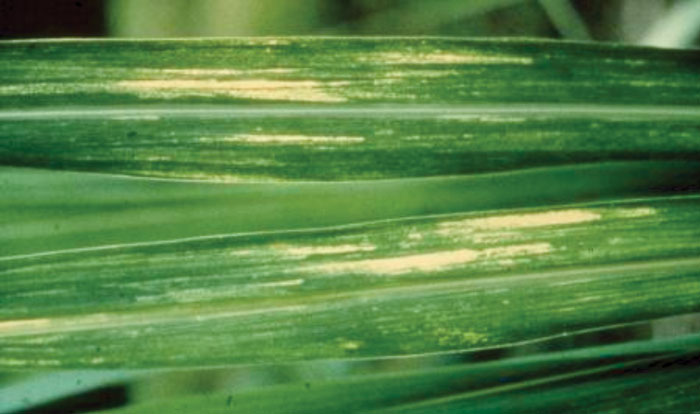
This shows deficiency symptoms of molybdenum. It appears similar to deficiencies in nitrogen and sulfur. Apt Nutrition
Moly is also found to deactivate viruses, decrease incidences of Phytophthora and nematode, and reduce sprouting in stored grains. This micro tends to like soil pH a little higher than average, so it’s probably best foliar applied, Hoorman says.
Driving the Bus — Boron and Calcium
Boron is closely related to calcium and plays a major role getting calcium into plants. Too much of either nutrient will tie up the other. “Everything in the soil is about balance,” Hoorman says.
“I’m seeing almost all soil tests, the boron levels are way, way too low. I think we’ve overdone it with this boron toxicity concern,” Hoorman says. “Generally, a pint per acre works. I have some guys now putting on a gallon per acre and seeing real good results from that. The only time to worry about boron toxicity is if you have sandy soils. Clay soils have enough buffering capacity that you don’t need to worry about it.
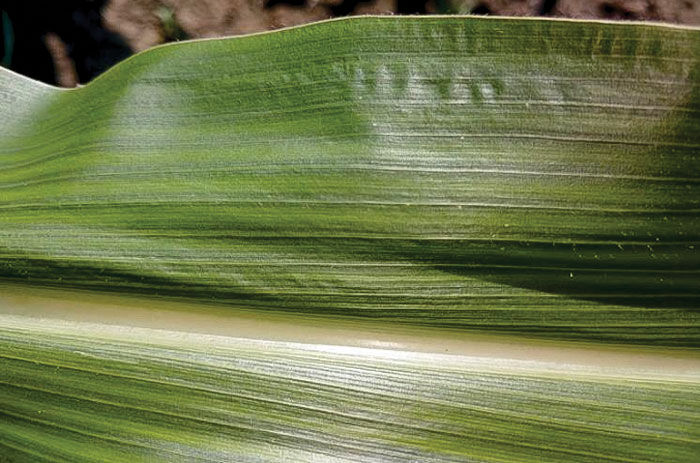
What boron and calcium deficiency looks like in corn. Look for the parallel tracks on the outside of the leaf. Texas A&M University
There is one other variable to watch with boron availability — potassium levels, as too much of that nutrient can reduce boron levels, Hoorman notes.
Calcium plays a crucial role by activating dozens of key enzymes in plants that optimize yields. Calcium is mobile, so Hoorman advises spring application right after planting at 200-300 pounds an acre to ensure calcium is plant available.
Calcium deficiency is often associated with many plant diseases, including powdery mildew, pythium, sclerotinia, fusarium and rhizoctonia, so calcium is essential as a defense mechanism. “It stabilizes a plant and helps provide good flocculation in the soil,” he adds.
The Healer — Sulfur
Sulfur used to be abundant when it was deposited during rainfall, but environmental laws have reduced sulfur from the air, cutting what’s provided from about 20-30 pounds an acre to 6-10 pounds. That means no-tillers must pay close attention to soil tests to ensure there’s enough in their soil profile.
Sulfur is an “electron donor” and a “great antioxidant that helps control light, drought, wounds, cold weather and even helps you with heavy metals,” Hoorman says, adding that brassicas are a good source of sulfur as well as ammonium thiosulfate.
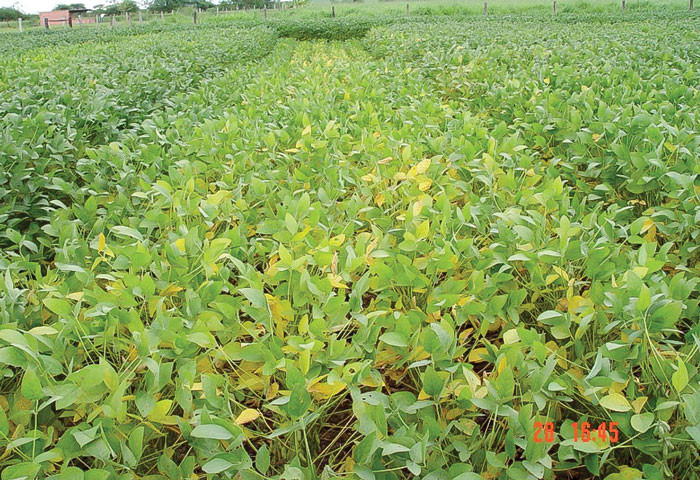
Yellowing leaves, shown here in soybeans, indicate a sulfur deficiency. Univ. of Georgia
“You need 20 pounds of sulfur per acre per year, minimum, on your soil test,” he says. “Every 1% organic matter gives you two-and-a-half pounds. For every 10 pounds of nitrogen, you need a pound of sulfur. Most will add just an extra unit of thiosulfate with your corn, you’re only accounting for the nitrogen that you’re applying, not the other nitrogen in the soil. So our soils are becoming depleted of sulfur and it doesn’t hurt to up that just a little bit.”
Hoorman notes some work conducted by Purdue Univ. Extension agronomist and Strip-Till Hall of Famer Tony Vyn revealed that applying 20-30 pounds of AMS in soybeans at about R1 produced a 10–20-bushel yield increase in some instances.
“Now we don’t get it every year. Maybe there’s difference in sulfur concentrations coming out of soil, but that’s something you might want to look at. Sometimes we’re not getting enough nodulation out there for those soybeans to maximize its yield,” Hoorman says.
The Defender — Zinc
Hoorman says researchers are finding out this nutrient could be one of the most yield limiting. But traditionally it plays an important role in breaking down diseases and pathogens. It also helps activate more than 300 enzymes, although many of those are redundant.
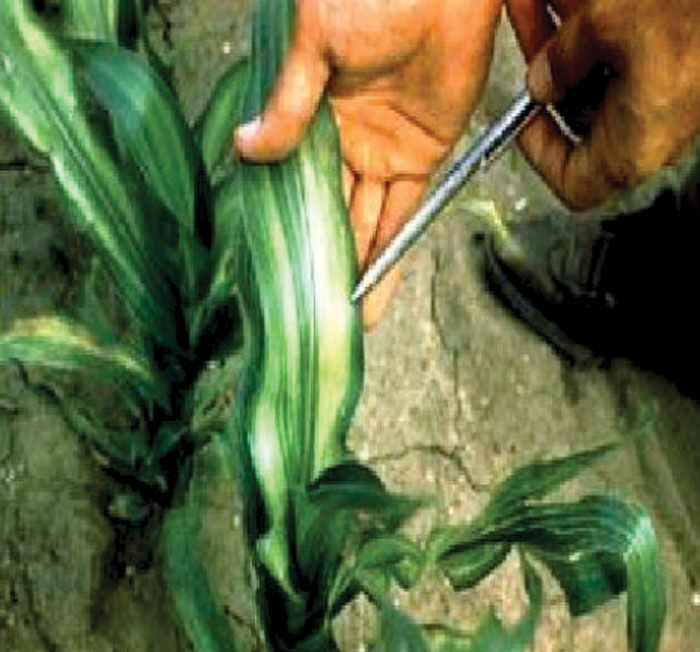
Zinc deficiency in plants can present as a wide, white midrib, which should be green in healthy plants. Univ. of Georgia
Hoorman adds there was a discussion at a conference a couple of years ago that problems with tar spot may be due to deficiencies, as well as iron, copper, manganese and even silicate. He suspects if no-tillers pay closer attention to applying these micros in the proper amounts, and the right time, foliar fungicide applications could be reduced or eliminated.
“Almost all of the different diseases are associated with either a nutrient deficiency or a nutrient excess,” he says.
The Body Builder — Copper
This micronutrient is a central element used in enzyme making cellulose and lignin, so it’s critical for stalk stability and vascular structures. Excess copper decreases N, P and iron and vice versa.
“Add a little copper and you’ll have better stalk strength. And it’s real important,” he says.
Only 5% of soil copper is plant available. The micronutrient tends to be tied up in high-pH soils but is more readily available in low-pH soils, Hoorman says. Although copper is most abundant in organic residue, in no-till fields it can take 2-3 years to mineralize. Cereal rye, peas, triticale and canola can all be good sources of copper.
The Scientist — Manganese
Manganese activates more than 36 enzymes, splitting water molecules so the plant can make proteins. It’s needed for carbon dioxide fixation at C4 in corn plants and it accelerates germination and maturity, while increasing the availability of P and calcium.

Yellowing between the veins in young plants could indicate a manganese deficiency. Univ. of Georgia
It’s more plant available in a reduced form and is often deficient in soybeans, and magnesium can negatively affect its availability. Manganese can help decrease most fungus and bacterial diseases, but it may increase viral diseases, he adds.
Manganese is highly chelated by glyphosate, Hoorman says. Many no-tillers using Roundup Ready soybeans have complained before about taking yield hits when using glyphosate with that trait.
“When you put on glyphosate in the spring, your soil health will decline for 6 weeks until it recovers,” he says. “You put on glyphosate at R1 and you’ll lose pods. We’re losing anywhere from 10- 20 bushels on soybeans.”
Last to the Party
Soil health is a journey and in the process of building a healthy soil profile, yield increases are sometimes the last thing to go up, Hoorman says.
“If you start building your carbon, you’ll get better aggregation, better water infiltration, better water-holding capacity — and then all the sudden, everything comes together.
“It might take you 3, 5 or 7 years. If we were starting in virgin soils we wouldn’t have this problem. But we’ve done so much tillage and so much compaction, and we’ve lost so much organic matter for the soil, we’ve got to build some money back into it.”

